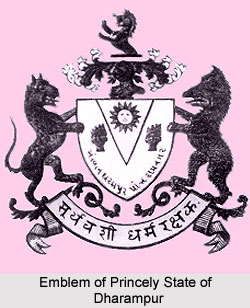 The Princely State of Dharampur was one of the princely states of India that were administered by native rulers or Indian princes under the indirect control of the British Government of India. The Sisodia Rajput dynasty was the ruling family of the state. The territory covered a total area of 1,823 sq km and comprised of a total population of 123,326 in the year 1941. It was incorporated as a part of the Baroda Agency, which was a sub division of the West India States Agency. Later it became a part of the state of Gujarat. At present the erstwhile native state is situated in Dharampur city, in the Indian state of Gujarat. The region is on the banks of river Swargavahini, which is at the foothills of the Sahyadri mountain range.
The Princely State of Dharampur was one of the princely states of India that were administered by native rulers or Indian princes under the indirect control of the British Government of India. The Sisodia Rajput dynasty was the ruling family of the state. The territory covered a total area of 1,823 sq km and comprised of a total population of 123,326 in the year 1941. It was incorporated as a part of the Baroda Agency, which was a sub division of the West India States Agency. Later it became a part of the state of Gujarat. At present the erstwhile native state is situated in Dharampur city, in the Indian state of Gujarat. The region is on the banks of river Swargavahini, which is at the foothills of the Sahyadri mountain range.
History of Princely State of Dharampur
The Princely State of Dharampur was established by Ram Raja, who was the 2nd son of the then ruler of Udaipur, in 1262. During the reign of Mughal Emperor Akbar, the native ruler accepted the overlordship of the Mughal dynasty. In the year 1802, under the Treaty of Bassein, the suzerain rights of the Peshwa over Dharampur were transferred to the British East India Company. The Princely State of Dharampur was honoured as one of the salute states of India, with a gun salute of 9 guns by the British Government of India. Dharampur state was a part of the former Bombay Presidency. Dharampur, also known as Ramnagar, was the southernmost Gujarati state. The princely state was covered by the British district of Nasik in the east and west; by Bansda in the north; and by the Portuguese enclave of Dadra and Nagar Haveli in the south. The region was around 40 miles in length from north to south, and approximately 20 miles in width. Dharampur state included 272 villages and one town in the year 1911.
The courts of the princely state exercised full civil and criminal jurisdiction. The native ruler, who held the title of Maharana, took charge of the administration of the state. The Maharana of Dharampur was an original member of the Chamber of Princes in his own right. After the withdrawal of the British and the independence of India on 15th August 1947, the native ruler acceded his state to the newly formed Union of India, also known as the Dominion of India on 10 June 1948.
Rulers of Princely State of Dharampur
The list of the native rulers of the Sisodhyia dynasty of the princely state of Dharampur is mentioned as follows-
* Rana Maharana Sahib Ramdevji (1860)
* Rana Maharana Sahib Narayandevji Ramdevji (1860- 1891)
* Rana Maharana Sahib Mohandevji Narayandevji (1891- 1921)
* Rana Maharana Sahib Vijaidevji Mohandevji (1921- 1947)



















